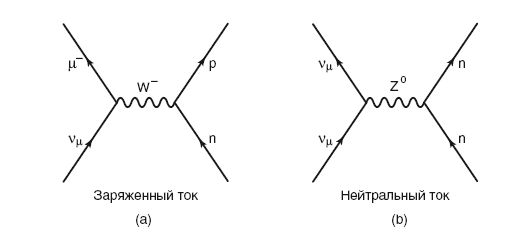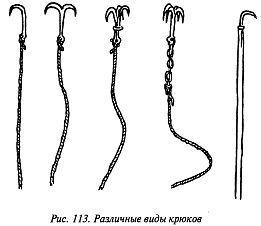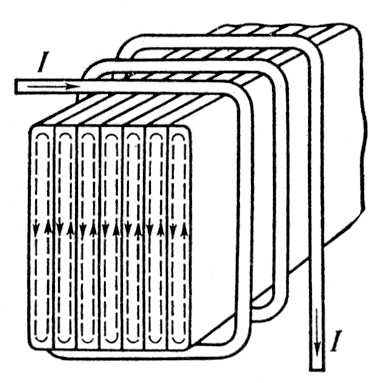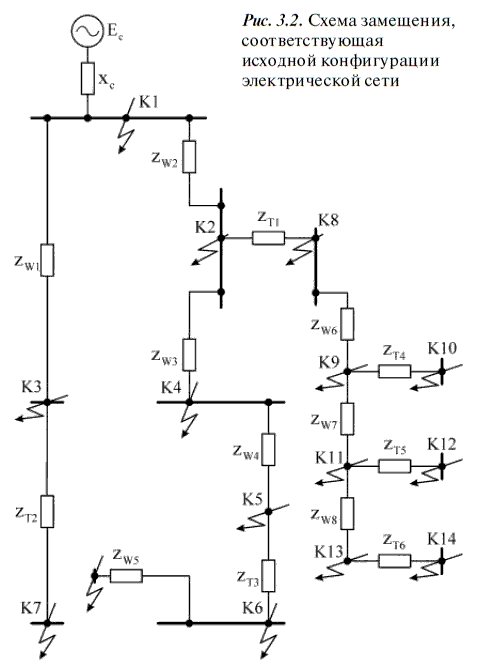Vector and axial-vector weak currents in unitary symmetry and quark model
All the observed semileptonic interactions are well described in the lowest order by the interaction Hamiltonian, which relates the lepton currents to the weak hadronic current containing the vector and axial parts:
where We note that they enter the lepton current on an equal footing, which corresponds to the -universality hypothesis. In what follows, the symbol I will be used to denote or and the symbol for the corresponding neutrino or
Let us consider semileptonic processes of the type where are hadron systems. In the lowest order, the transition amplitude is
where the states are determined only by strong interactions. This expression is similar to formula (2.5), which describes the process The matrix element of the lepton weak current is again singled out as a simple and well-known factor, and all the complexity of strong interactions lies in the matrix element from the hadronic current. Semileptonic reactions "probe" hadronic states with the help of a current operator. For decay processes, the structure is the same as described above, except for the obvious replacement of the neutrino spinor with an antineutrino spinor. Note that, according to the agreement we have adopted, the current increases electric charge hadrons per unit: In processes where the charge of hadrons decreases by one, the matrix element from the conjugate operator contributes, the lepton current, of course, must also undergo corresponding changes.
As in the case of the electromagnetic current, at the present time it is not possible to specify a method for constructing weak currents from fundamental hadronic fields. Let us try to describe the properties of currents in the most general view, so that the consequences do not depend on the details of the construction. Of course, it is possible that special models can lead to a good idea. In fact, this is exactly what happened with the ideas of the algebra of currents. As already mentioned, it is known that with respect to Lorentz transformations it behaves like a sum
vector and axial: In some processes, for example, only the vector part contributes; in others, for example, only and for the rest, for example, both parts. Currents conserve baryon charge. As for strangeness, and contain parts that preserve strangeness and change it by one, are correlated: It is possible that there are other currents, say with or but since there are no experimental confirmations for them, we will not consider these possibilities. In relation to the isospin, it is considered that currents with are transformed as a charge-increasing component of the isovector, and currents with as a charge-increasing component of the iso-doublet. Apparently, terms with other properties with respect to the isotopic spin are not required. Therefore, for all well-established currents, we can write:
The properties of the currents with respect to the change in the third isospin component can be omitted, since they follow from the relation recorded, no, and that all new factors can be included in the currents. Later, we will discuss some ideas that will allow us to more accurately define the concept of scale and give the angle an objective meaning. Now we note that the angle is called the Cabibbo angle.
For currents without a change in strangeness (vector and axial), we introduce one more attribute by which they can be classified. This is parity, which is characterized by an isotopic rotation around the second axis by an angle that changes the sign and the charge conjugation operation, which also changes the sign. Generally speaking, it is not necessary that and and also belong to the same multiplet. But if, nevertheless, the currents and their conjugate currents enter the same multiplet, then they can be assigned a certain -parity: or It is known that the vector current c is even with respect to the -transformation, and the axial current is odd. There is currently no room for alternative possibilities. Recall that the isovector part of the electromagnetic current has and the isoscalar part
The isovector part of the electromagnetic current is thus the neutral component of the isotopic triplet with
Whereas the charge-increasing and charge-reducing terms, generally speaking, are of another isotopic triplet. It can be assumed that in fact it is one and the same triplet. This is the famous CVC conjecture of Gerstein-Zeldovich, Feynman and Gell-Man. It has received some experimental confirmation and leads (if it is really correct) to significant simplifications. It is known that electromagnetic currents, isoscalar and isovector, are stored separately. The CVC hypothesis is so named because it requires the conservation of the vector current without changing the strangeness: Now, with the help of isotopic symmetry, one can relate the corresponding matrix elements for For example, for -mesons at rest. content.
The properties of weak and electromagnetic currents with respect to isotopic transformations and hypercharge are now fully defined. But one more symmetry of strong interactions remains, namely, It is not a strict symmetry. But assuming that it is not violated very much, the question arises as to how the various currents are transformed under the action of For all the currents that we have already discussed, the simplest possibility, consistent with isotopy and hypercharge, is that they are transformed as members of the -octet. However, Cabibbo suggested something stronger, namely that all vector currents (weak and electromagnetic) are included in one common octet. Then the isoscalar electromagnetic current is a triplet of electromagnetic and weak strangeness-preserving currents, as well as weak currents with a change in strangeness, are transformed under the action in the same way as Cabibbo also assumed that all axial weak currents belong to one octet of axial operators. These hypotheses, if correct, lead to enormous simplifications, since only two independent objects remain to be studied: the vector and axial octets. In each of them, various members are connected to each other. This means, in particular, that the relative scale per octet is fixed. Moreover, the absolute scale is also fixed in the vector octet, since this octet contains the charge and hypercharge operators. Now, it seems, it only remains to fix the scale of the axial octet with respect to the vector octet, which, however, is difficult to do for objects that have different transformation properties with respect to the Lorentz transformation. Nevertheless, ambiguity remains - after all, there is not quite a strict symmetry of strong interactions. Is it possible to give -properties such a meaning that will be preserved even if violated found a solution to both problems. This will be discussed below.
The very weak current /c f is not taken into account in this figure. When approaching f / c 0, when / ce becomes much larger than all the other components, the resulting current increases rapidly.
The measurement of very low currents is technically difficult problem. Therefore, it is difficult to register individual particles with the help of an ionization chamber, and it is usually included in integrated systems intended for registering particle or γ-ray fluxes.
Continuous charging with very low currents is used not only to replenish the internal losses of the battery, but also to compensate for intermittent discharges of small magnitude.
They respond to very weak currents, sometimes only thousandths of an ampere, and are 10 to 20 times more sensitive than conventional electromagnetic devices.
Electrochemical detectors register a very weak current that occurs when chlorine interacts with an electrolyte. Colorimetric sensors use photocell signals that determine the color intensity of a reagent that changes color when interacting with chlorine.
| Current-voltage characteristic of a three-electrode lamp. The curve shows the dependence of the anode current /a on the voltage Uf between the grid and the cathode.| Scheme of operation of a three-electrode lamp as a current and voltage amplifier. |
A very weak current passing through this resistance, say, one microampere (10 - a), will create a voltage Ucl-JR on this resistance according to Ohm's law. In our example, this voltage is equal to one volt. But with such a change in the grid voltage, the anode current changes by 2–3 mA. Therefore, a change in current through the grid resistance by 1 μA causes a change in the anode current several thousand times greater. We thus amplify the initial very weak current by several thousand times, delivering the necessary energy through the operation of the anode battery.
These electrometer tubes allow very low currents of the order of a few microamperes, a slope of the order of several microamperes per volt, and a gain of the order of unity.
In this case, they work with very weak currents of 0 1 ca, which makes this method suitable for all common solvents, with the exception of hydrocarbons.
At the same time, they work with very low currents of about 0-1 mA, which makes it possible to use this method for the distillation of all common solvents with the exception of hydrocarbons.
In this case, they work with very weak currents of 0 1 (ha), which makes this method suitable for all common solvents, with the exception of hydrocarbons.
A sensitive galvanometer is needed to measure the very low current flowing in the chamber. This method, however, requires additional time for processing photographic materials, and at present, some models of polarographs use galvanometers paired with a recording device.
| Block diagrams of electronic voltmeters. - a direct current with a microammeter yes as an output device. b direct current, in which the measured direct voltage is first converted into alternating voltage (by a modulator unit, and then amplified and detected. c alternating current, in which the measured voltage is converted by the detector (over a wide frequency range into a DC voltage, and then amplified. d in the 1st circuit, the measured alternating voltage is amplified and then detected, in the 2nd circuit there is no detector and the indicator is a thermoelectric. milliammeter.| Structural circuits will measure, generators. a f - generated frequency, and - amplified alternating voltage of frequency / (output power of the amplifier 1 - 5 em. b The voltage divider standard signal generator circuit allows you to get an output voltage from 1 to 0 1 μv. voltage and modulation factor m are measured by an electronic voltmeter and modulator.| Structural diagram of a rectangular pulse generator. From a relaxation generator of short-term pulses with a repetition period T, an update is started - euflpamoj, at the output of which rectangular pulses of a certain duration / and are obtained. |
Along with electricity and light, low currents and low-current wiring provide comfort and convenience in our home. The voltage in low-current systems is 12-24 V, while the current strength is measured in milliamps. Today, not a single house or room can be imagined without low-voltage networks. Since these wires with low voltage provide us with telephone, Internet, television, uninterrupted operation of computers. In other words, low-voltage systems are systems for receiving terrestrial and satellite television, a telephone network and the Internet, video surveillance systems, fire alarms, intercoms, local networks and a distribution cable network, as well as wire broadcasting systems (radio).
It should be said that installation of low-voltage networks must be carried out in parallel with other internal engineering systems. At the same time, it is necessary to pay attention to some nuances that are important in the quality and uninterrupted provision of communication, Internet, television, video surveillance and security services. For example, low-current cables are required to be run at least 0.5 m from power cables to prevent electromagnetic interference and the negative effects of unbalanced currents. The intersection of low-current cables with power cables should be at an angle of 900. Low-current cables laid outside the premises and buildings must be protected from mechanical damage with metal overlays. Distribution boxes on the wall must be located at least 300 mm from the ceiling. In addition, junction boxes should not be installed above windows, openings and doors.
In addition, a low-current wiring route, for example, from a junction box to a telephone must be straight and shortest. In addition, open wiring along the walls should be at a height of more than 50 mm from the ceiling and 25-30 mm from the floor. It should be said that open laying is carried out in cable channels and is usually not practiced in dwellings. Hidden wiring can be carried out through the channels of embedded devices of a convenient height. Hidden wiring is carried out in strobes along the walls, in PVC sleeves under the raised floor and in floor screed, behind false ceilings. In this case, low-current sockets are mounted on walls or in floor hatches.
Wiring to the end device must be done with a solid wire, without splicing. To exclude the impact of radio transmissions on telephone conversations, a certain distance must be maintained between the wires of the telephone network and wire broadcasting (radio) laid in a common box. For example, with a line length of 10 m, the distance should be at least 15 mm, 50 mm with a length of 70 m. In addition, low-current lines of television and video surveillance systems must be grounded to protect against atmospheric discharges and unbalanced mains currents.
After tracing a low-current system, you must perform covert work plan. On this plan, it is required to depict the entire route of the low-current system in the room, the location of all junction boxes and outlets. The presence of such a plan will greatly facilitate the implementation of subsequent repair and installation work in the room.
WEAK CURRENTS
small currents used in telegraph, telephone, signaling, and other similar installations (S. t. installations).
- - see Diadynamic ...
Big Medical Dictionary
- - electr. currents induced in conductive parts electr. machines and apparatuses and closed within these parts. V. t. cause heating of those steel parts in which they are formed ...
Technical railway dictionary
- - citizens who, due to their objective capabilities, cannot be self-supporting without social assistance measures. See also: Social protection of the population ...
Financial vocabulary
- - a small-scale reward for good work, provided along with punishment for omissions and misconduct ...
- - electric currents in the earth when using it as a conductive medium. Causes corrosion of metal. things in the ground...
Natural science. encyclopedic Dictionary
- - cohesive soils having a shear strength in natural occurrence of less than 0.075 MPa or a modulus of settlement at a load of 0.25 MPa of more than 50 mm/m; need to be upgraded or replaced...
Construction dictionary
- - denotes traders who do not have a stock personalities forced to sell their shares at the slightest drop in their price ...
Financial vocabulary
- - "... Weak soils: cohesive soils having a natural shear strength of less than 0.075 MPa or a settlement modulus of more than 50 mm / m at a load of 0.25 MPa ...
Official terminology
- - So called. in electrical physics...
- - one of the genera of hornbills, which includes the smallest species of the family. The beak of T. is devoid of a horn-shaped appendage. In terms of lifestyle, they are similar to other hornbills ...
Encyclopedic Dictionary of Brockhaus and Euphron
- - one of the four types of known fundamental interactions between elementary particles...
- - tokei, a lizard of the gecko family. Length up to 36 cm. Coloration of the upper side of the body: brick-red and white rounded spots on a gray or bluish background ...
Great Soviet Encyclopedia
- - who. Jarg. corner. About a scared person. Maksimov, 238...
Big Dictionary Russian sayings
- - currents imaginary in magnets, going in the south pole from left to right, in the north pole. vice versa...
Dictionary foreign words Russian language
- - vibes...
Synonym dictionary
- - 1) strong position - pronunciation conditions in which all the differential features of phonemes appear: for vowels under stress and in an open syllable ...
Dictionary linguistic terms T.V. Foal
"WEAK CURRENTS" in books
natural electric currents
From the book Absolute Healing. Systemic and information-energetic mysteries of our health author Gladkov Sergei MikhailovichNatural electric currents On the surface of the human body there are many, several hundred main and tens of thousands of minor, special points. The electrical conductivity in them is noticeably higher than that of adjacent skin areas. With their help, acupuncture
Chapter 16 INDUCED CURRENTS
From book 6. Electrodynamics author Feynman Richard Phillips6 Alternating neutral currents
From the Higgs Boson book. From scientific idea before the discovery of the "particle of God" author Baggott Jim 
6 Alternating Neutral Currents A chapter in which protons and neutrons have an internal structure, and the predicted neutral currents of the weak nuclear force are found, lost, and found again.
Toki - "climbing equipment"
From the book Claws of the Invisible [Genuine Ninja Weapons and Equipment] author Gorbylev Alexey Mikhailovich 
Currents - “climbing equipment” During their night operations, “invisibles” often had to overcome palisades, walls, climb roofs of houses, trees, and climb mountain steeps. To make life easier for themselves, the ninja invented many special currents -
WOKI-TOKI
From the book Russian rock. Small encyclopedia author Bushueva SvetlanaVOKI-TOKI The group was founded in Gdynia (Poland) in 1988 by Andrey Safonov and Sergey Krasilnikov. The musicians regularly performed in Gdynia, Sopot and Gdansk (Poland). Liepaja (Latvia), Murmansk and other cities, and in 1997 took part in the St. Petersburg project
Eddy currents
From the book Big Soviet Encyclopedia(VI) author TSB 
Currents
From the book Great Soviet Encyclopedia (TO) of the author TSBTelluric currents
From the book Great Soviet Encyclopedia (TE) of the author TSBElectric currents
From the book Great Soviet Encyclopedia (EL) of the author TSBFoucault currents
From the book Great Soviet Encyclopedia (FU) of the author TSB3.3. Short circuit currents
From the book Relay protection in electrical distribution networks B90 author Bulychev Alexander Vitalievich 
3.3. Short-circuit currents It is necessary to determine the effective values of short-circuit currents in all places (according to the diagram) of the installation of protections (places of current control by protections) in the maximum and minimum operating modes electrical system in case of damage at the calculated points. For settlement
FET bias currents
From the book OrCAD PSpice. Analysis electrical circuits by Keown J. 
FET bias currents The circuit with automatic bias is shown in fig. 11.4. In the built-in model for n-channel JFET, the default values for a number of parameters have been changed. The new values are shown in the following input file: n-Channel JFET Bias CircuitVDD 4 0 18VRG 1 0
Diadynamic and sinusoidal modulated currents
From the book Salt Deposition. Diagnosis and treatment author Olshanskaya Ekaterina SergeevnaDiadynamic and sinusoidal modulated currents This is a type of apparatus physiotherapy, which may well be carried out in the ward during the hospitalization of a patient with acute pain caused by osteochondrosis of the spine. The patient hardly feels any
Currents of Moscow
From the book Cross of Chubais author Berger MichaelCurrents of Moscow Moscow is the capital of our Motherland. Because the Kremlin and the president are here, because the government and the parliament are here, because it is written in our Constitution, finally. And also because Luzhkov is here. Yuri Mikhailovich is the same attribute of the capital as Red Square
Earth currents
From the book Psychosis of Planet Earth author Ostrovsky Boris IosifovichCurrents of the Earth On October 5, 1960, a third World War. On the radar screens of the American military base in Tula (Greenland) a group of unidentified objects arose. The UFOs were rapidly moving west towards the United States of America. That's how
4.1 Introduction to the weak interaction
Let us now consider the application of the unitary symmetry model and the quark model to the description of the processes of weak interaction of elementary particles.
A few words about the weak interaction. As is known, muons, neutrons, -hyperons decay by weak interaction. We mentioned the muon here because leptons are (today) point-like, i.e. structureless particles, and their coupling constants with the quanta of various fields appear, so to speak, in their pure form, they are not obscured by the structure of the particle, as is the case with hadrons. The decay of a muon into an electron and two neutrinos is characterized by the Fermi constant G F ~ 10 -5 m p -2 . The decay of a neutron into a proton, an electron and an antineutrino is characterized by practically the same coupling constant. At the same time, the weak decay of -hyperon into a proton, an electron, and an antineutrino is characterized by a much lower coupling constant. The same difference is characteristic of the decay constants of the nonstrange pion and the strange kaon into leptons. Does this mean that weak interactions, unlike electromagnetic ones, are not universal? May be so. Is it possible to save versatility? It turns out you can, and this was done by Cabibbo in 1964 by introducing Cabibbo's angle C. It suffices to assume that weak interactions without strangeness violation are specified not by the Fermi constant G F , but by the constant G F cos C , and weak interactions with strangeness violation are specified by the constant G F sin C . This hypothesis was brilliantly confirmed in the analysis of numerous weak decays of mesons and baryons with both conservation and violation of strangeness. The value of the Cabibbo angle is ~ 13 o .
And how to describe the weak interactions of elementary particles?
We know that the electromagnetic interaction can be specified by an interaction Lagrangian of the form current x field
In this case, say, the scattering of an electron or a muon on an electron occurs at least in the second order in e. We can effectively write the scattering in the form current x current
In this case, the current should have the form
J μ (x) = (x) Oμ ψ μ (x) + ν e (x) Oμ ψ e (x) + p (x) Oμ ψ n (x) cos C + p (x) Oμ ψ Λ (x)sin C . |
By domestic quantum numbers the current describing the decay of the neutron is similar to the - meson, and the current describing β
-decay Λ
-hyperon, similar to K - -meson. Note that weak currents are charged. Since 1956, it has been established that weak currents do not preserve parity. This is one of the fundamental properties of the weak interaction. Structure Oμ for charged weak currents was found from the analysis of numerous angular distributions and turned out to be a linear combination of a vector and an axial vector, Oμ = γ μ (1 + γ 5) , which is often referred to as the (V-A) version of the Fermi theory. In this case, the hadron coupling constants at 5 are, generally speaking, renormalized (they get an additional factor, which it would be good to be able to calculate theoretically).
The dimensional Fermi constant, as shown by comparison with the electromagnetic process in the second order in e, may be a reflection of the existence of a very heavy W-boson, which is emitted by leptons and hadrons like a photon. Then the observed decay processes of the muon, proton, hyperons are processes of the 2nd order in the coupling constant g W , and G F ~g W 2 /(q 2 + M W 2), and the value of q 2 can be safely neglected.
And then the elementary act of interaction with a weak field can be written not through the product current ×
current, but simply by modeling the electromagnetic interaction.






